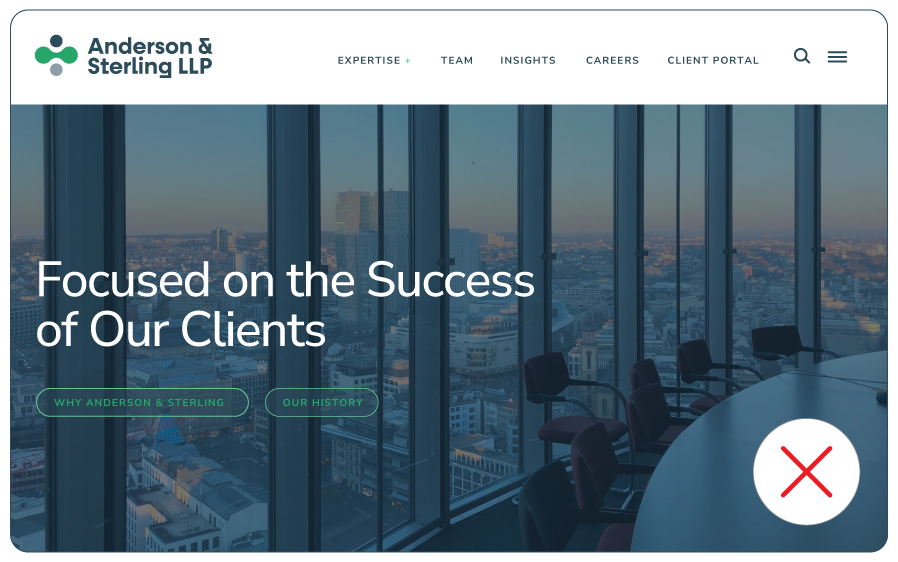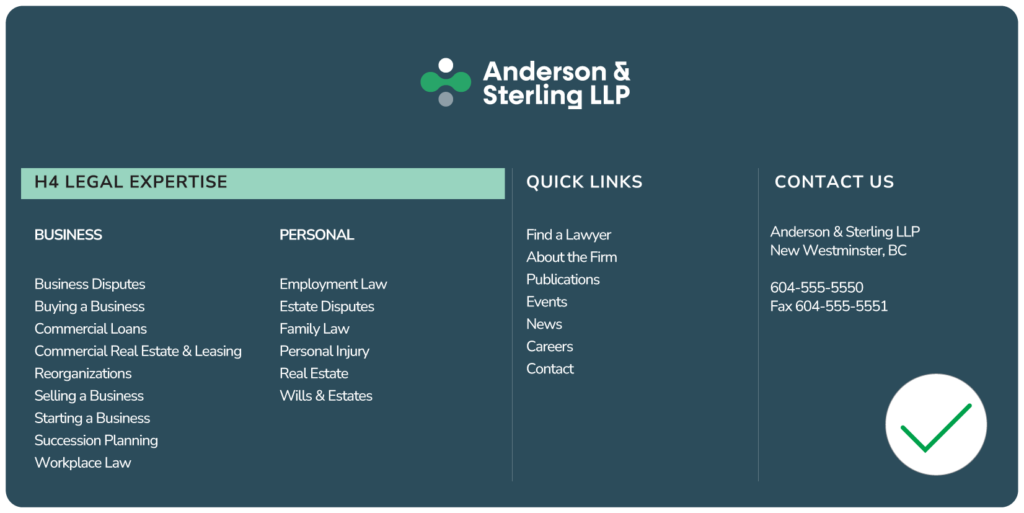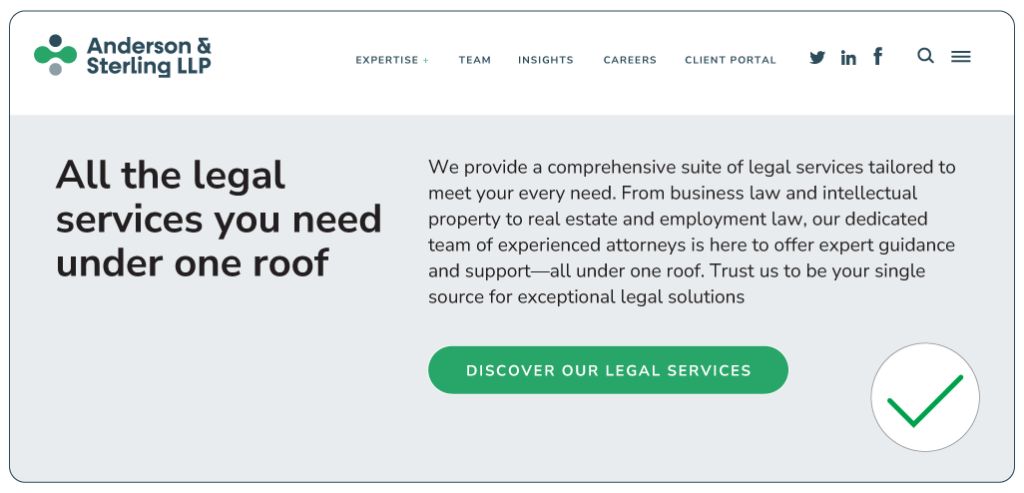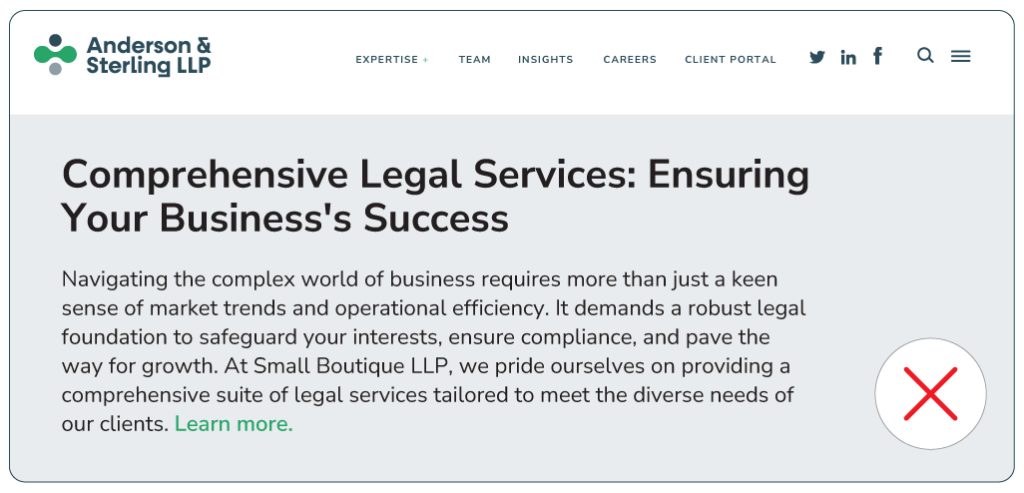As the holiday season gets closer, it’s the perfect time for law firms to show their clients how much they care. This time of year is all about relationships, and...
September 23, 2024
How to improve law firm SEO in 2024: 10 Actionable tips
Search engine optimization practices are constantly evolving, and it’s important to keep pace with best practices to improve law firm SEO in 2024 and beyond. Otherwise, you risk poor search engine results and higher bounce rates.
If it’s been a while since you did an SEO inventory of your site, now is a great time to make sure it’s friendly to users and search engines alike. Here are our actionable tips to make significant SEO improvements.
5 things to remove to improve SEO
Get rid of unclear headlines
Headlines serve as the first impression for both users and search engines. An unclear headline can lead to high bounce rates as users may not find the content relevant to their search intent. For search engines, a vague headline makes it challenging to understand the page’s primary topic, potentially leading to lower rankings.

Incorrect

Correct
Actionable Tip: Craft headlines that are both descriptive and engaging. For instance, instead of “Our Services,” use “Comprehensive Web Development Services.” This approach clarifies the content and incorporates keywords that improve SEO.
Remove headings within template parts
Headings (H1, H2, H3, etc.) are crucial for SEO as they help search engines understand the structure and hierarchy of the content. Using these headings in template parts like footers or sidebars wastes their potential and can confuse search engines about the page’s main content.

Incorrect

Correct
Actionable Tip: Ensure that headings are used strategically in the main content areas. Use them to break down the content into digestible sections, each focused on specific keywords. For example, instead of having an H2 heading in the footer for “Contact Us,” use a plain text link and reserve the H2 for a subtopic within your main content.
Remove sliders or carousels
Sliders and carousels can slow down page load times, negatively impacting SEO. Additionally, users often ignore them, especially if they move too quickly or contain too much information. Sliders also require manual testing to troubleshoot accessibility issues, which can further affect search engine optimization.


Actionable Tip: Focus on a single, compelling image or message instead of a slider. This reduces load time and ensures users see the most important information immediately. If you must use a slider, make sure it loads quickly and keeps the number of slides to a minimum.
Remove social media icons in the header
Social media icons in the header can distract users and lead them away from your site before they have engaged with your content. This increases bounce rates and can negatively affect SEO.
Actionable Tip: Position social media icons in the footer or a dedicated section on the site where they are accessible but not distracting. This keeps users on your site longer, allowing them to engage with your content and reducing bounce rates.
Remove thank you pages
Thank you pages often serve a single purpose and provide little value to users or search engines after the initial interaction. Indexing these pages can clutter search results with irrelevant content.
Actionable Tip: Display a thank you message directly on the form submission page or use a modal popup. If a thank you page is necessary, ensure it is set to noindex to keep it out of search engine results. This approach maintains user engagement and keeps search engines focused on more important content.
5 things to do to improve SEO
Place meaningful buttons
Buttons and link anchors should be descriptive to provide context to users and search engines. Generic phrases like “Read more” don’t tell search engines anything about the link’s destination, missing an opportunity to reinforce keywords and relevance.

Incorrect

Correct
Actionable Tip: Use button texts that describe the action or content, such as “Discover Our Legal Services” instead of “Learn more.” This improves SEO and enhances user experience by providing clear expectations.
Noindex date archive and category/tag pages
Date archive and category/tag pages often contain duplicate or thin content that provides little SEO value. Indexing these pages can dilute your site’s overall SEO effectiveness.
Actionable Tip: Use the “noindex” meta tag for date archive and category/tag pages to prevent search engines from indexing them. This directs search engines to focus on more valuable pages, improving your site’s SEO performance. Regularly audit your site to identify and update any pages that should be noindexed.
Add alt text for images
Alt text helps visually impaired users understand image content and provides another opportunity to include keywords for SEO. Search engines use alternative text to index images, making it easier for your site to appear in image search results.
Actionable Tip: Write concise, descriptive alt text for each image, including relevant keywords where appropriate. Avoid keyword stuffing; instead, focus on accurately describing the image. For example, instead of “image1.jpg,” use “Alt text: A professional web developer working on a laptop.”
Do your keyword research
Effective SEO relies on using keywords that match what real people are searching for. Your content should align with user intent. Proper keyword research can help you achieve higher search rankings and increased traffic.
Actionable Tips: We recommend doing keyword research at least every 2 years to ensure you’re not missing any new opportunities for organic traffic.
- Utilize keyword research tools like Google Keyword Planner, SEMrush, or Ahrefs to identify relevant keywords.
- Focus on long-tail keywords that have lower competition and higher relevance to your audience.
- Continuously refine your keyword strategy in response to evolving search trends and user behavior.
Add more anchored links in the blog
Internal linking helps search engines understand the relationship between different pages on your site. Anchored links within blog posts can drive traffic to key service pages and distribute page authority throughout your site.

Incorrect

Correct
Actionable Tip: Identify opportunities to link to related service pages or other relevant content when writing blog posts. Use descriptive anchor text that includes keywords to provide context to search engines. For example, instead of “click here,” use “learn more about our Legal services.”
Sign Up To Our Newsletter
